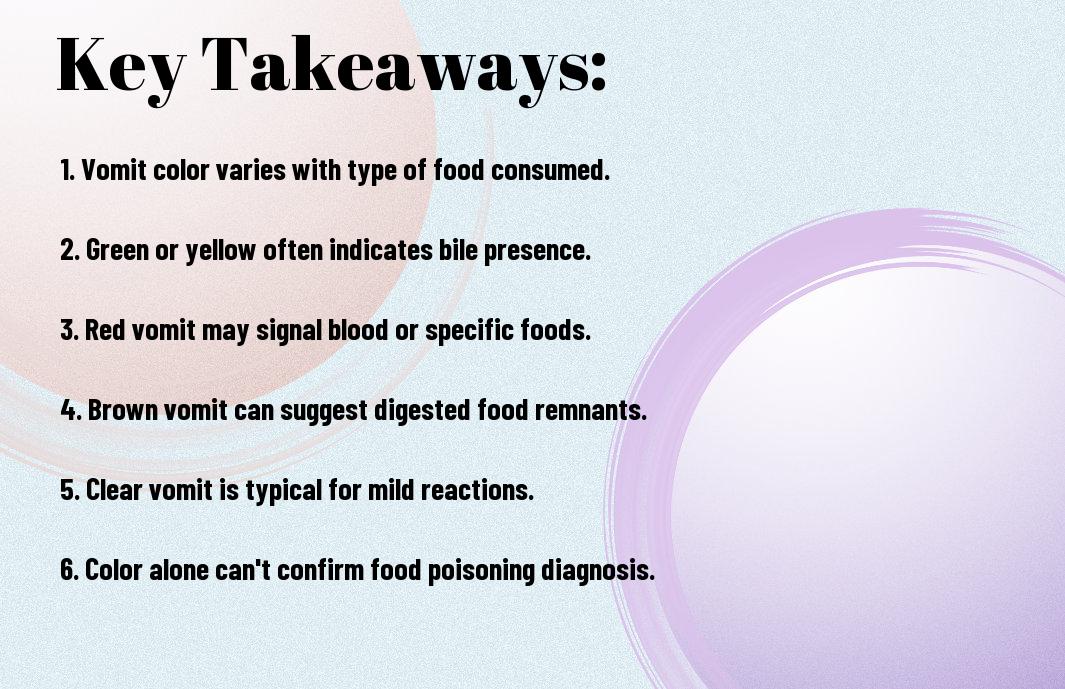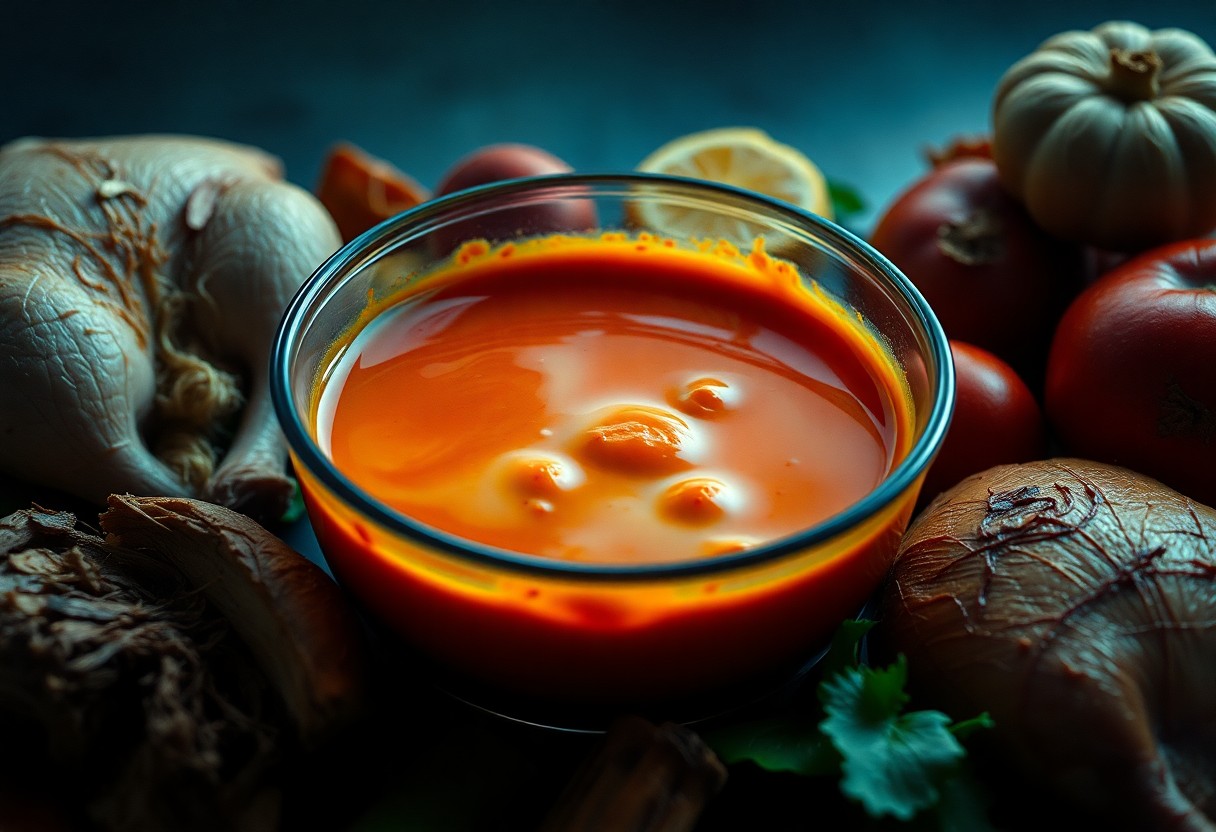Food poisoning can cause a range of symptoms, including vomiting, which can vary in color. You may wonder what the color of vomit indicates about the severity and type of foodborne illness you are experiencing. This post will provide you with imperative information about the different colors of vomit associated with food poisoning, helping you better understand your symptoms and when to seek medical attention. From green and yellow to blood-tinged hues, knowing what to look for can aid in your recovery and ensure your well-being.
Key Takeaways:
- Color Variation: Food poisoning vomit can vary in color, often appearing yellow, green, or brown, depending on the type of food consumed and the person’s digestive state.
- Presence of Blood: Vomiting blood, indicated by red or dark brown color, may signal a serious condition requiring immediate medical attention.
- Severity Indication: The color and consistency of vomit can indicate the severity of food poisoning; lighter colors may suggest milder cases, while darker hues often point to more severe reactions.
Understanding Food Poisoning
Your knowledge of food poisoning can help you avoid potential health risks. Food poisoning occurs when you consume contaminated food or beverages, leading to a range of symptoms that can manifest within hours or days. Understanding the causes and symptoms can empower you to make safer food choices.
Definition and Causes
Below are several reasons why you may experience food poisoning. Common culprits include bacteria like Salmonella, E. coli, and Listeria, as well as viruses such as Norovirus. Improper food handling, cooking, or storage can lead to contamination, making you susceptible to foodborne illnesses.
Common Symptoms
Common symptoms of food poisoning include nausea, vomiting, diarrhea, abdominal pain, and fever. These symptoms can vary in severity, depending on the type of contaminant and your individual health.
This condition can lead to dehydration and other complications if not managed properly. In general, symptoms can last from a few hours to several days. It is important to stay hydrated and seek medical attention if your symptoms persist or worsen, ensuring that you address any serious health concerns promptly.

The Color of Vomit
One common aspect of food poisoning is the color of vomit, which can vary significantly based on various factors. These colors can range from clear to yellow, green, or brown, and can often provide insight into the source of the gastrointestinal distress. It is important to pay attention to the vomit color as it may indicate the severity of your condition and the presence of specific toxins or irritants in your system.
Factors Influencing Vomit Color
On your journey to understanding vomit color, several factors influence its appearance. These include:
- Diet: The foods you consumed prior to vomiting
- Hydration levels: Dehydration can lead to concentrated vomit
- Medical conditions: Underlying health issues may alter vomit color
Perceiving these variations offers valuable context for your symptoms and may prompt you to seek medical advice.
Interpretation of Vomit Colors
Across various contexts, the interpretation of vomit colors can provide vital clues about your health. Understanding what each color may signify can aid in better assessing your condition and determining the urgency of your situation.
Further exploration into vomit colors highlights specific meanings. For instance, green or yellow vomit may indicate the presence of bile, which typically suggests that your stomach is empty. Brown vomit may be a sign of digested blood, prompting immediate medical attention. Clear vomit could hint at excessive water intake or an empty stomach. Recognizing these indicators will empower you to respond appropriately if food poisoning occurs.

Specific Colors and Their Significance
For many, the color of vomit can signal the underlying cause of food poisoning. Understanding these colors may help you gauge the severity of your condition and whether you need to seek medical attention. Colors like green, yellow, red, and brown each hold significance that you should be aware of, as they can inform you about what’s happening inside your body. Being knowledgeable about these indicators can aid you in making informed decisions about your health.
Green or Yellow Vomit
Specific shades of vomit, such as green or yellow, often indicate that your body is expelling bile. This typically happens when your stomach is empty, and your digestive system is reacting strongly to the toxins. If you notice these colors, it may suggest your food poisoning episode is particularly severe, highlighting the need for careful monitoring of your symptoms and hydration levels.
Red or Brown Vomit
Against common assumptions, red or brown vomit can be alarming and suggests the presence of blood or old blood in the gastrointestinal tract. This discoloration may arise from severe irritation or damage, requiring immediate medical evaluation to determine the underlying cause.
Consequently, if you experience red or brown vomit, it’s necessary to pay close attention to other symptoms you might be encountering, such as abdominal pain or dizziness. These can indicate more severe conditions, such as gastrointestinal bleeding, warranting urgent attention from a healthcare professional. Always prioritize your health and consult a doctor if you observe these troubling signs.
Diagnosis and Treatment
Despite the discomfort food poisoning causes, diagnosing the condition typically involves a thorough review of your symptoms and potential exposure to contaminated food. Healthcare providers may suggest testing your stool to identify the specific pathogen responsible. Treatment often focuses on hydration and rest, as most cases resolve without the need for medication. In severe instances, antibiotics or other therapies may be necessary, especially if a bacterial infection is involved.
When to Seek Medical Help
For certain symptoms such as persistent vomiting, high fever, or signs of dehydration like dry mouth and dizziness, seeking medical assistance promptly is important. If your symptoms worsen or do not improve within a few days, contact a healthcare professional for further evaluation and potential treatment options.
Preventive Measures
When preparing or consuming food, maintaining proper hygiene is important to reduce the risk of food poisoning. Ensure that you wash your hands thoroughly before and after handling food, cook meals to the appropriate temperatures, and store leftovers promptly in the refrigerator.
Plus, be vigilant about the food you purchase; always check expiration dates and prefer to buy from reputable sources. Avoid cross-contamination by using separate cutting boards and utensils for raw and cooked foods. Understanding safe food handling practices can significantly lower your chances of experiencing foodborne illnesses.
Personal Accounts and Case Studies
Many individuals have documented their experiences with food poisoning, shedding light on the various symptoms and colors of vomit they encountered. Here are some case studies to consider:
- Case Study 1: A 30-year-old male reported bright yellow vomit after consuming undercooked fish, diagnosed with Vibrio parahaemolyticus infection.
- Case Study 2: A family of four exhibited dark green vomit after a picnic, linked to spoiled mayonnaise-based dishes.
- Case Study 3: An 18-year-old female experienced brown vomit after eating beef tacos contaminated with E. coli.
- Case Study 4: A child showed clear, watery vomit following consumption of expired dairy products, confirmed as a case of norovirus.
Anecdotal Experiences
Along your journey through various dining experiences, you may hear anecdotes from friends and family about their own food poisoning episodes. These stories often highlight unusual colors of vomit and emphasize the distressing effects of contaminated food on personal health.
Expert Opinions
Around the world, health professionals emphasize the importance of understanding the symptoms associated with food poisoning. They often note that the color of your vomit can provide insights into the type of foodborne illness you may be dealing with.
Plus, experts state that the analysis of vomit color can indicate the severity and type of food poisoning, as greens may suggest spoiled vegetables while browns can indicate gastrointestinal bleeding. Understanding this information can empower you to seek the appropriate medical care early, ensuring better health outcomes in the event of a foodborne illness.
Myth vs. Reality
Keep in mind that many misconceptions surround the color of vomit associated with food poisoning. People often believe that specific colors directly indicate the severity or type of food poisoning. However, this is not always the case, as various factors can influence vomit color, making it necessary to look beyond just the hue for accurate information.
Misconceptions about Vomit Color
Before stepping into the reality of vomit color, it’s necessary to unpack some common misconceptions. Many assume that green or yellow vomit always signals a severe health issue, while others believe that different colors can reveal the specific type of food poisoning. These beliefs, while prevalent, can lead to unnecessary panic and misinterpretation of symptoms.
Facts to Consider
After debunking those myths, it’s vital to focus on facts that contribute to the understanding of vomit color during food poisoning. The color of vomit can vary due to several elements, including the contents of your stomach, hydration levels, and the specific food that caused the reaction. It’s important to consider these factors rather than jumping to conclusions based solely on color.
To make informed decisions regarding your health, observe all symptoms, not just vomit color. Various conditions can influence coloration, such as bile presence or the type of food consumed. If you experience persistent vomiting, especially accompanied by other alarming symptoms like fever or dehydration, seek medical attention. Relying solely on vomit color may divert your focus from recognizing the overall health issue at hand.
Conclusion
Presently, understanding the color of food poisoning vomit can help you identify possible health issues. Typically, vomit can vary in color from clear to yellow, green, brown, or even red, depending on what you have consumed and the severity of your condition. If you are concerned about your symptoms, it’s advisable to consult a healthcare professional. You can refer to a detailed Vomit Color Chart: Throwing-Up Yellow, Green, Black or Red to better understand the implications of your vomit color.
FAQ
Q: What color is food poisoning vomit?
A: Food poisoning vomit can vary in color, commonly appearing yellow, green, or even brown. The color can be influenced by the type of food consumed and how long it’s been in the stomach. Yellow vomit is often bile, which indicates that the stomach is empty, while greenish hues may indicate the presence of bile or undigested food. Brown vomit may result from partially digested food mixed with bile.
Q: Why does the color of vomit change with food poisoning?
A: The color of vomit can change due to several factors, including the type of food that was ingested, the time it’s spent in the digestive system, and the body’s reaction to toxins. When food is vomited, digestive juices, including bile, can mix with the contents, altering the color depending on what was eaten and how long it’s been in the stomach.
Q: Is green vomit a sign of food poisoning?
A: While green vomit can be a symptom of food poisoning, it does not exclusively indicate this condition. Green vomit is often associated with bile, which can occur when the body expels stomach contents due to irritation or infection, including foodborne illnesses. Other causes, such as certain medical conditions or bile reflux, can also lead to green vomit.
Q: Can the color of vomit indicate the severity of food poisoning?
A: The color of vomit itself does not directly indicate the severity of food poisoning. However, it can provide some insight into the body’s state. If vomiting is accompanied by blood or a persistent change in color, it may suggest a more serious condition that warrants medical attention. It’s important to assess other symptoms, such as dehydration and abdominal pain, for a better evaluation.
Q: When should I seek medical help for vomit color changes?
A: You should seek medical assistance if vomit appears consistently in unusual colors, such as red or dark brown, which can indicate blood or digested blood. Additionally, if vomiting persists for an extended time, is accompanied by severe abdominal pain, fever, or signs of dehydration (such as reduced urination or dry mouth), it is advisable to consult a healthcare professional for guidance and treatment.



